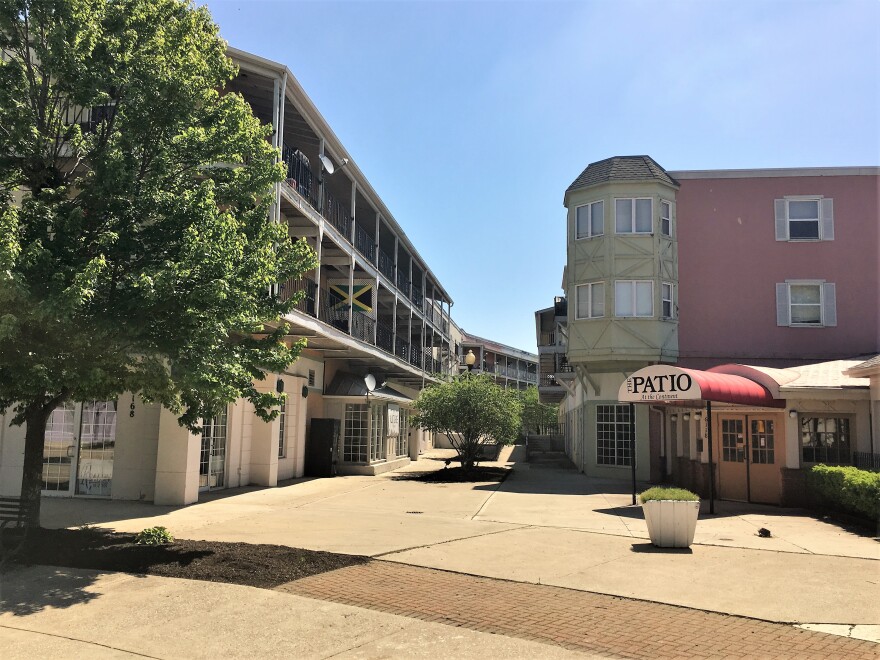This story is part of the Curious Cbus project. You ask the questions, you vote for one of the questions and we answer.
Everyone knows The Continent has fallen on hard times. But once, it bustled the way Easton Town Center does now.
Once, visitors would stroll through quaint, European–style streets, or sit and dine in open-air cafes. Children watched the dancing waters of a playful fountain.
These days, the shopping center on Busch Boulevard in North Columbus sees very little retail activity. If it weren’t for the large number of French-themed apartments in the complex, The Continent would be dead.
"The Continent began in Columbus in 1972 and its heyday was really in the ‘70s and ‘80s," says Emmy Beach of the Ohio History Connection. "That was a time when people were visiting not only for retail experiences but also for entertaining and dining experiences as well."
More than 40 years ago, The Continent’s developers—led by the late Bill Bonner—executed a then-groundbreaking strategy: They created, in essence, a French village.

The walkways were narrow to evoke a European feel. Apartments, modeled after the French Quarter in New Orleans, stood just three or four stories high, with cafes spilling out onto sidewalks. Beach says the open-air retail was a unique concept at the time, with mixed-entertainment and residential offerings.
And the centerpiece was the French Market.
"It was also set up like a European-inspired French Market where people could come and get locally made foods and shop with local vendors, and it was a really wonderful area for folks to gather and to experience a different kind of retail destination," Beach says.
You can find a few videos of The Continent in its heyday on YouTube, showing a thriving commercial development well into the '90s.
"Truly good and unique stuff," one Reddit user wrote in a thread about The Continent. "A spice store with the biggest selection in town, knife stores, tobacco stores, cheese stores, wine stores. You could find stuff there under one roof you pretty much couldn't find elsewhere. Layer on top of it cool residents, and lots of night life, you have a happening place…really special for its time."
"I had an apartment there in 91/92? It was really fantastic," wrote another user. "All the young people you can imagine, all the bars and restaurants you could want, party after party, live music, the Gathering on Thursdays, etc. the movies were great, tons of people would congregate outside by the water fountain."

But other shopping and entertainment venues began chipping away at The Continent’s popularity. Beach says that its popularity began to wane in the 1990s.
"We don’t know if there’s one specific reason for that," Beach says. "It could be a combination of things. One, there was a lot of increased competition from other retail shopping areas: City Center opened up in the late ‘80s, that kind of pulled crowds away. We see Polaris, Tuttle Crossing and even Easton popping up and really people are visiting those areas more."
The Continent's own layout may have contributed to its decline.

"That North Columbus area where the Continent was located was becoming more isolated as people were flocking to these newer, suburban areas for entertainment and dining opportunities, and because The Continent was set up like more of a European-style market the streets were more narrow," Beach says. "It was a more compact shopping space so there wasn’t a lot of room for change and growth."
Easton Town Center, which opened in 1999, stood in contrast. It took a similar concept—open-air retail dining and shopping—but made it larger, more navigable.
"While The Continent was a destination on its own, Easton seems to have refined that idea a little bit more," Beach says. "And they’ve had more space to experiment."

On the other side of town, within The Continent, sidewalks once filled with customers are empty now. Most retail establishments have shut down or left, and there are an abundant number of business spaces for rent. Only the movie theater, indoor sports complex and a smattering of restaurants remain in the area.
The pastel colors of The Continent’s buildings have faded, and in some places they are cracked and peeling. Still, The Continent had a powerful impact on the many who visited—and on the way Columbus thinks about entertainment.
"People in Columbus that had the experience with The Continent, they had a lot of great memories and it was really a wonderful destination for family and friends to gather on the weekends and get a new experience that they had never had before," Beach says. "So even though it doesn’t exist in the way that it once did, the memories there are still alive."
Got your own question about Central Ohio? Ask us below for Curious Cbus.





